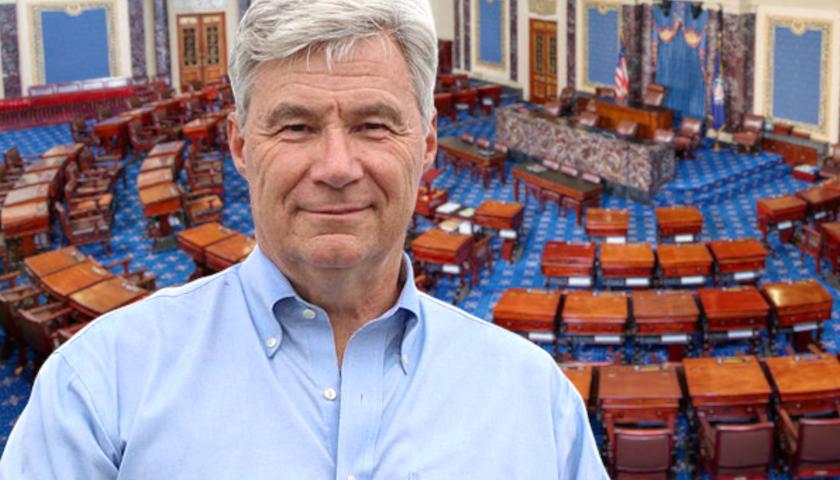by Kevin Killough
A Democratic Party-led Senate Budget Committee hearing Wednesday pressed on with the narrative that climate change is one of the leading causes of unaffordable homeowners insurance rates and canceled coverage.
Committee Chair Sen. Sheldon Whitehouse, D-R.I., took the narrative a step further to suggest that the climate-driven financial problems in the insurance industry are driving economic problems for the entire nation.
“This isn’t all that complicated. Climate risk makes things uninsurable. No insurance makes things unmortgageable. No mortgages crashes the property markets. Crashed property markets trash the economy,” Whitehouse said in his opening remarks.
However, one witness and a few senators pushed back against the unproven narrative.
Dr. EJ Antoni, a research fellow with the Heritage Foundation, testified that there’s no empirical evidence to support the claim that increases in the frequency and intensity of storms are driving the increased cost of insurance. He argued that the primary drivers of the increases in rates and canceled insurance policies are inflation, lawlessness in large cities, and people building more expensive homes in high-risk areas.
“The widespread rioting caused by groups like BLM and Antifa in 2020 caused $100 billion in damages — a massive financial loss for the insurance industry. Likewise, general lawlessness in American cities over the last several years, and the refusal of government authorities to protect private property has resulted in more damages, more claims and ultimately, higher premiums,” Antoni said.
Data and science
Whitehouse referred to a New York Times article that blamed climate change for the insurance industry losing money on homeowners coverage in 18 states last year, many of them in the West and Midwest. Whitehouse said this shows that hail, wind storms, and wildfires are now rivaling earthquakes and hurricanes as the most “prevalent perils.” That article focused on correlation, but not causation.
The Rhode Island senator cited the “Billion Dollar Disaster” tally of National Oceanic and Atmospheric Administration (NOAA) to show trends in extreme weather events are increasing.
New research by Dr. Roger Pielke Jr., a science-policy researcher at the University of Colorado Boulder, discovered numerous flaws in NOAA’s methodology. Namely, no discernible trends in extreme weather trends can be detected with trends in disaster costs over time, the study finds, and when this data factors in changes in the amount of impacted development over time, there’s no increased trend in disaster costs.
Chris Martz, a meteorology senior at Millersville University and intern for the Committee for a Constructive Tomorrow (CFACT), published a report this week that uses NOAA’s weather data to show there are no trends in hail or wind storms. NOAA’s Storm Prediction Center (SPC) keeps detailed records on various weather events, including hail, Martz explained. Since 2010, the number of annual reported hail events, according to the SPC, has actually decreased by 2,340 reports per decade.
Martz noted a number of limitations in the data, which may result in changes in the future, but says that currently there’s no indication that hail events are increasing in the United States.
In its latest scientific assessment report, the Intergovernmental Panel on Climate Change, a United Nations consortium of the world’s leading climate scientists, finds no projected increase in hail or severe wind storm frequency or intensity, even under the most extreme, implausible emission scenario.
Real problems
The insurance companies are facing real financial problems in the homeowners markets.
“They remain very profitable on things like car insurance and life insurance policies. But year after year, it is true that insurance companies are losing billions of dollars on homeowners insurance, especially in areas that are at high risk along the coast,” Martz told Just the News. “But the reason that this damage is increasing is not because there’s been an increase in hailstorms.”
During the Senate committee hearing, Deborah Wood, a former Florida resident, told the story how she and her husband lived in Florida for 43 years, with manageable increases in their homeowners insurance up until about 2017, when they paid $3,700 per year. Between 2017 and 2023, she said, they saw their insurance costs rise to over $8,000, and that was after making $40,000 in improvements, such as hurricane-resistant windows, to their home.
While no one disputed the existence of the problems in the insurance industry, many others tried to draw attention to regulatory compliance costs and inflation instead of blaming “climate change.”
Ranking Member Sen. Chuck Grassley, R-Iowa, said that it was the 19th hearing on the topic of climate change, while much bigger problems, such as the “exploding” $34 trillion debt” continues to grow.
“The majority continues to crusade against fossil fuel companies. They want to bully insurers into abandoning their diversified portfolios so they stop underwriting all fossil fuel projects. If the majority gets their way, Americans can expect to pay much more to put gas in their cars and to heat their homes,” Grassley said.
Sen. Ron Johnson, R-Wis., said that the premise of the hearing — climate change — was “completely off.” He went over the other contributing factors to the financial problems in the insurance industry — inflation, regulatory barriers, riots and lawlessness, and high costs of insuring properties in high-risk areas — and asked Antoni from the Heritage Foundation to estimate the percentage each of these factors contribute to the problem.
Antoni answered that since these factors arise out of government actions, it’s hard to separate them, but he estimated about 90% of the increased insurance premiums over the last several years were attributed to a failure to respond to criminal activity, regulatory costs, and inflation. Inflation, he noted, was responsible for about 75% of the increased costs.
Sen. Mitt Romney, R-Utah, argued that addressing climate change, which would require a global effort, wasn’t going to produce results, especially with the increased emissions out of China’s coal-driven economy. China is the world’s largest annual greenhouse gas emitter.
“The idea that somehow we’re going to fix climate and solve the insurance problem is pie in the sky. That’s avoiding the reality that we can’t fix climate because it’s a global issue, not an American issue,” Romney said.
Romney said that better solutions would be fiscal reform to get inflation under control, ending subsidies for insurance that encourage people to build in high-risk areas like forests and coasts, and mitigation to make construction more resilient in the face of storms.
“If you want to live in a big house on the coast, you have to spend a lot of money to insure or take huge risks. That’s just the reality,” Romney said.
Climate risks
Others were, however, insistent that the insurance problems needed to be fixed by reducing carbon dioxide emissions.
Sen. Chris Van Hollen, D-Md., equated those disputing that trends in extreme weather were causing higher insurance premiums with those denying manmade global warming altogether.
“There are a lot of folks out there who still deny that climate change is real, and the impacts on the human component. I’ve always believed that when skeptics began to feel the impact in their pocketbooks, it would become more real,” Van Hollen said.
Van Hollen said that Swiss Re, a major global insurer, had done studies that conclude that the “growing risk from climate is the predominant factor in what they predict will be increasing costs due to climate risks.”
In fact, that is not what the study Van Hollen cited said. Swiss RE research says that, “To date, the main drivers of rising economic losses have been growth, urbanisation and associated asset value creation: there are more assets that need to be insured….Currently, climate change plays a relatively small role but we expect its associated losses will contribute more to economic losses in the future.”
Whitehouse said that experts in the insurance industry, as well as the major insurers themselves, are saying climate change is the problem.
“We’ve always heard other news here from entities that are funded by the fossil fuel industry,” Whitehouse said, referring to the Heritage Foundation.
According to the Heritage Foundation, most of its funding is from individuals and less than 2% of it comes from corporations.
Whitehouse asked Rade Musulin, principal with Finity Consulting, to elaborate on how climate change was impacting the industry.
“Regardless of whether we think we know what the future holds or not, it’s a well established practice in economics that uncertainty has a positive cost. And the more uncertain we are about things, the higher the cost is. And I think that’s a significant factor at play here, too,” Musulin said.
Martz said that it’s common for the industry to make indirect statements about the connection between climate change and insurance rates, and he believes that’s because they know the data to support the claim is weak.
“If they actually came out explicitly stating that climate change is causing insurance rates to rise, they would probably get big accusations of fraud. And that would be like a whole legal battle,” Martz said.
– – –
Kevin Killough is a reporter for Just the News.
Photo “Sen. Sheldon Whitehouse” by Senator Sheldon Whitehouse.





